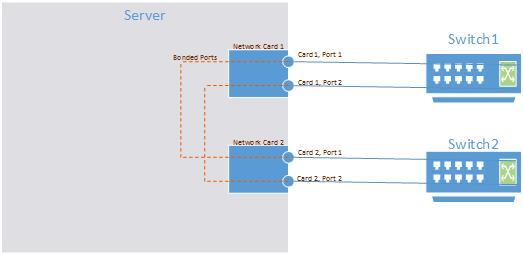
Stratus recommends that any hypervisors tagged as fault-tolerant run the Stratus ftServer with the KVM, VMware, or Hyper-V hypervisor. These locations can be ensured to have total redundancy. You must ensure duplicate networks and if using central storage, that the storage has adequate Quality of Service (QoS).
Once the hypervisor software has been added, you must make the node discoverable to the OpenStack installation. For more information, refer to:
http://docs.openstack.org/havana/install-guide/install/apt/content/nova-compute.html
All hypervisors discovered by OpenStack appear in the Stratus Management Console in the Hypervisors page.
In order to achieve the highest level of availability, the physical network connectivity must be redundant. Stratus suggests the following:
In the following diagram, the server contains two NICs, each with two ports. The ports are marked as Card1Port1 through Card2Port2.
Bond:
And connect the ports to two separate switches as shown.

Configure VLANs on the switch to match the configuration discussed in the previous section. Assign a temporary IP address, and verify network connectivity.
Consider the following recommendations when configuring storage:
|
Product Support and Downloads
|
About Stratus
|
|
Product Documentation (PDF Format)
|
About Help
|